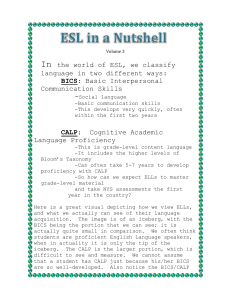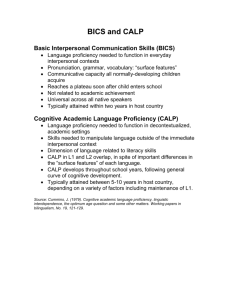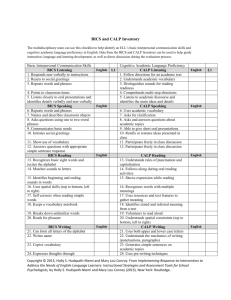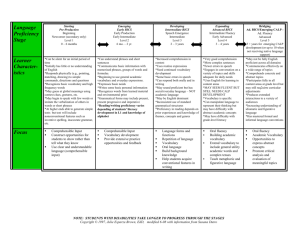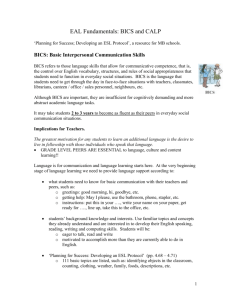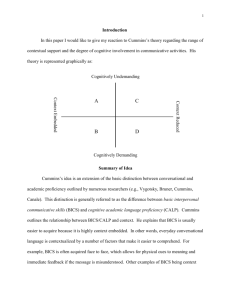English 418 Second Language Acquisition Session Fourteen Notes
advertisement
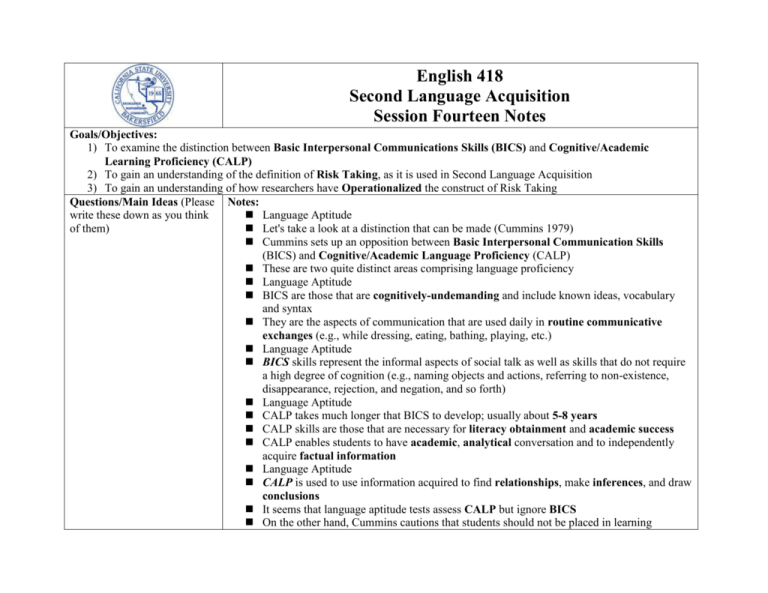
English 418 Second Language Acquisition Session Fourteen Notes Goals/Objectives: 1) To examine the distinction between Basic Interpersonal Communications Skills (BICS) and Cognitive/Academic Learning Proficiency (CALP) 2) To gain an understanding of the definition of Risk Taking, as it is used in Second Language Acquisition 3) To gain an understanding of how researchers have Operationalized the construct of Risk Taking Questions/Main Ideas (Please Notes: write these down as you think Language Aptitude of them) Let's take a look at a distinction that can be made (Cummins 1979) Cummins sets up an opposition between Basic Interpersonal Communication Skills (BICS) and Cognitive/Academic Language Proficiency (CALP) These are two quite distinct areas comprising language proficiency Language Aptitude BICS are those that are cognitively-undemanding and include known ideas, vocabulary and syntax They are the aspects of communication that are used daily in routine communicative exchanges (e.g., while dressing, eating, bathing, playing, etc.) Language Aptitude BICS skills represent the informal aspects of social talk as well as skills that do not require a high degree of cognition (e.g., naming objects and actions, referring to non-existence, disappearance, rejection, and negation, and so forth) Language Aptitude CALP takes much longer that BICS to develop; usually about 5-8 years CALP skills are those that are necessary for literacy obtainment and academic success CALP enables students to have academic, analytical conversation and to independently acquire factual information Language Aptitude CALP is used to use information acquired to find relationships, make inferences, and draw conclusions It seems that language aptitude tests assess CALP but ignore BICS On the other hand, Cummins cautions that students should not be placed in learning situations in which an L2 is used just because they have adequate L2 BICS Question? Assuming that there really is a distinction between BICS and CALP, can the distinction be used to explain what happens in actual (American) classrooms? Risk Taking It has been suggested that a tendency to take risks is associated with success in second language learning Also associated with a high tolerance for anxiety-inducing situations Many of the strategies associated with good language learning also seem to involve a willingness to take risks Risk Taking Beebe (1983): Risk Taking is defined as: a situation where an individual has to make a decision involving choice between alternatives of different desirability The outcome of the choice is uncertain There is a possibility of failure Risk Taking Rubin (1975), for example, characterized good language learners as: willing to guess willing to appear foolish in order to communicate willing to use limited knowledge of the target language in order to create novel utterances Risk Taking How does it play out? Beebe (1983): presented data from Puerto Rican bilingual (Spanish-English) children The children were interviewed on four occasions Once by a monolingual English interviewer Risk Taking Summary/Minute Paper Once by a bilingual (Spanish dominant) interviewer Once by a bilingual (English dominant) interviewer Once by all three interviewers, in groups of three children Children were having trouble with do insertion in WH-questions Risk Taking Beebe operationalized risk taking in terms of a number of factors: number of attempts to use particular grammar structures avoidance of such total amount of talk amount of information volunteering Risk Taking Results showed that risk taking was greatest with the monolingual English interviewer Beebe looks for an explanation in Giles’s Social Accommodation Theory (1979): People will unconsciously adjust their speech to fit their interlocutors (people they are communicating with) Risk Taking The bilingual children may have made their speech converge with that of the native speaker’s in order to gain the latter’s approval This suggests that learners’ willingness to take risks may depend on the situation, not just their general personality type IOW, how much potential gain or loss is there? Risk Taking Let’s take a look now at the article by Ely called "An Analysis of Discomfort, Risk-taking, Sociability, and Motivation in the L2 Classroom“
